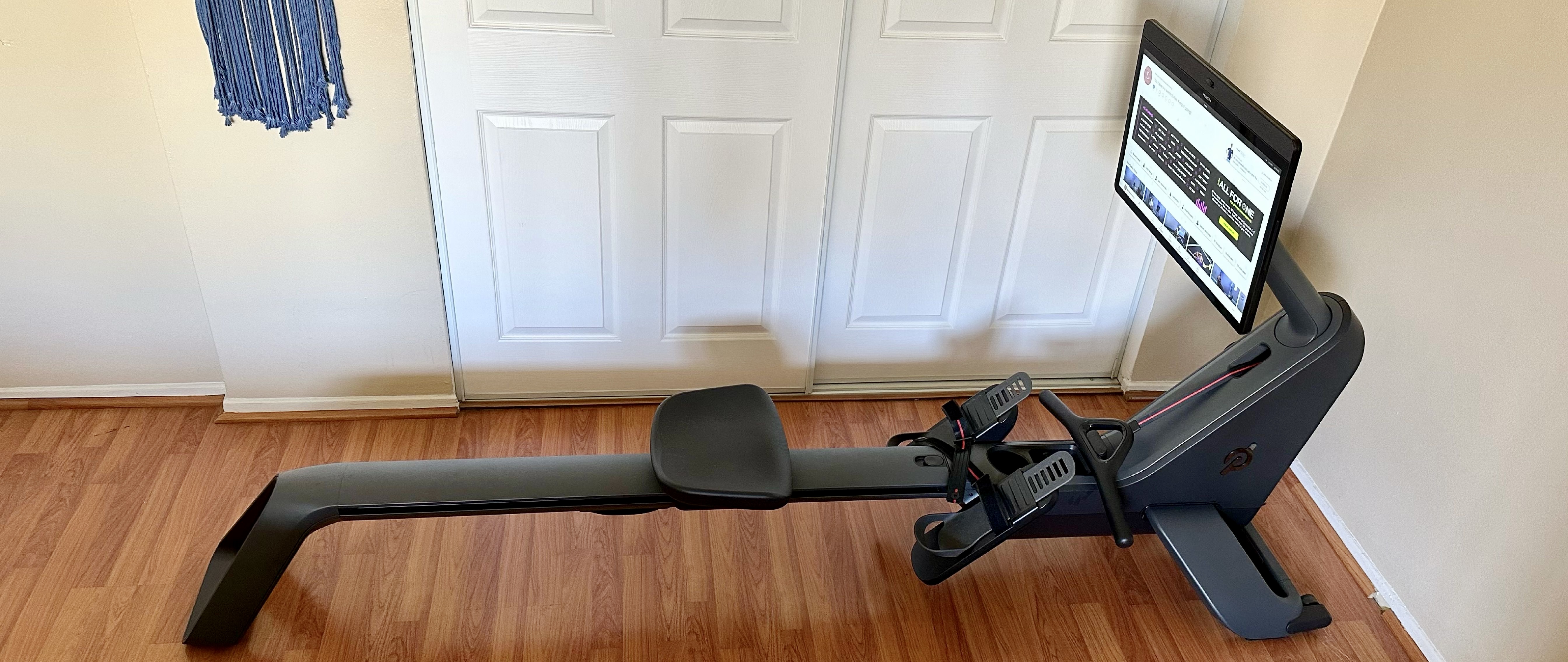
Peloton Row: Two minute review
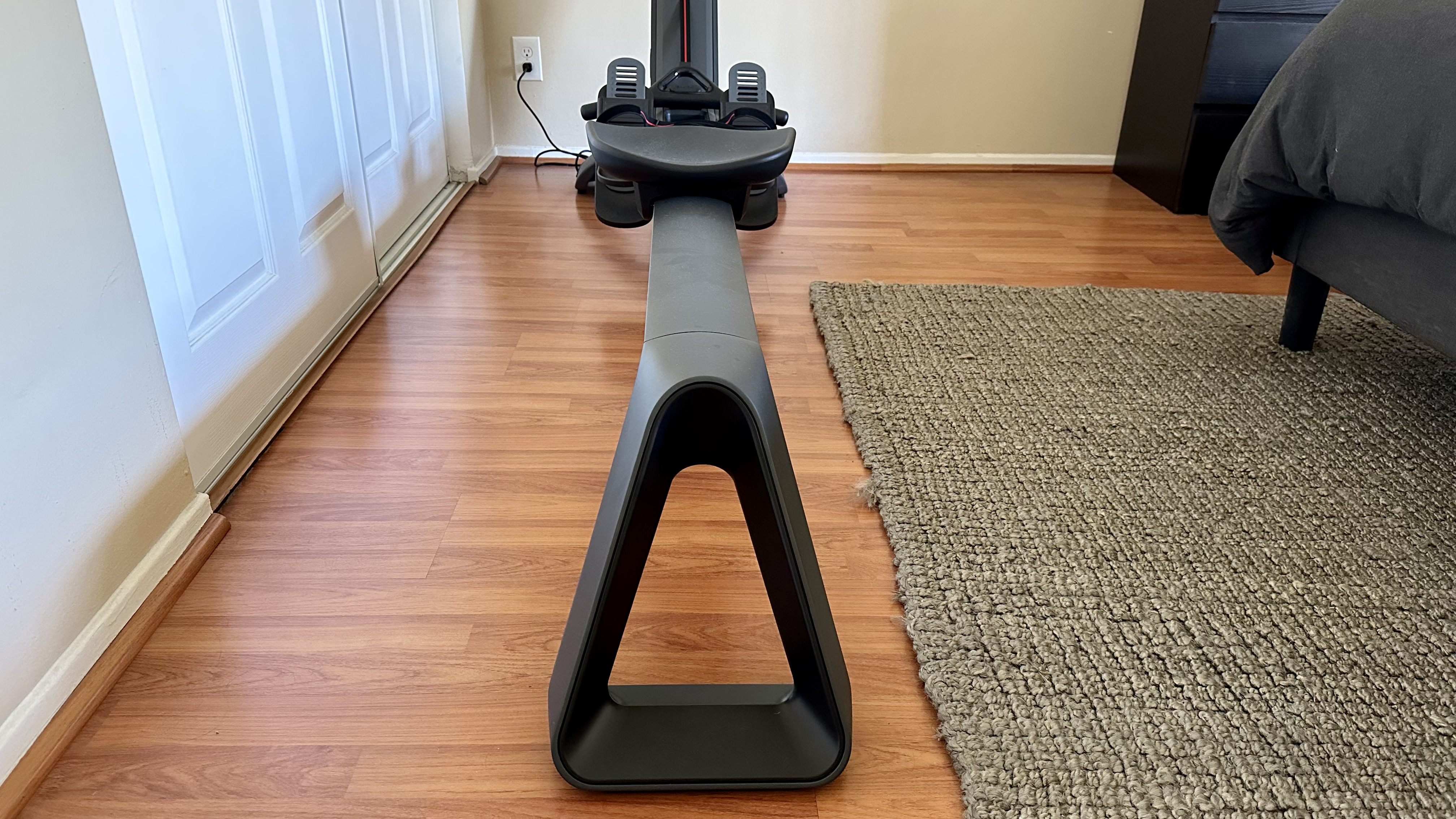
The Peloton Row is a beautifully designed and easy to use rowing machine that delivers a full body workout in the comfort in your own home. First released in December 2022, it’s the latest fitness equipment in Peloton’s high-end line up that includes the Bike, Bike+, and Tread, the latter of which made it onto our best treadmills list. Peloton is known for creating reliable, long-lasting products and pairing them with fun, motivating virtual class content, but all that greatness comes at a high price tag.
To make the most of the Peloton Row, you’ll need to be ready to shell out another $44/month for an All-Access Membership, in addition to the almost $3,000 up front. From there, you’ll get access to all of its classes, from yoga and meditation to cycling, running, strength training – and yes, rowing. Compared to other fitness memberships, like iFit from Nordic Track or a Hydrow membership, it’s honestly right on par, and in my opinion Peloton’s offerings a slightly superior. For people who love the livestreamed classes, it offers a ton of value, but its rival’s equipment costs significantly less.
Peloton offers Row and Row Bootcamp classes that range from five to 60 minutes, making it easy to fit a class into your daily schedule. The regular rowing classes include more basic music based classes as well as HIIT, endurance, Tabata, and interval options, while the Bootcamp classes mix rowing with strength training. You can even check the schedule and take live classes, though I find the times often cater to those on EST. Peloton is great with community building, using leaderboards to compete against others in your class, creating hashtags for more niche groups, letting you high five others in your class, and follow friends. The instructors are also all top-tier, fun, and motivating. There are a few scenic rows available for those looking to explore some waterways around the world, but there are still a limited amount available at the time of writing.
The build of the Row is equally as impressive as the classes. It’s definitely bulky and heavy like most other rowing machines, but Peloton makes it easy for you to store it upright, saving space when it’s not in use. You also don’t have to lift a finger during setup as a the delivering drivers do that, and then coach you through getting connected and calibrating the machine. All its components are durable and sturdy, and after over a month of almost daily use, work just as good as when I first got it. The large, 23.8-inch touchscreen immerses you in classes and is extremely responsive, bright, and easy to use.
I’ve found this machine especially caters those new to rowing. Beyond being easy to use, there’s a standout feature called Form Assist, which uses sensors to track your movement in real time and offer feedback to correct your form. It’s helped me significantly improve my stroke, and you’ll even get a handy performance score at the end of each class. There are also Form and Drills classes that beginners will appreciate. But even veteran rowers will love everything that the Peloton Row offers.
Peleton Row review: Specifications
Peloton Row: Price and availability
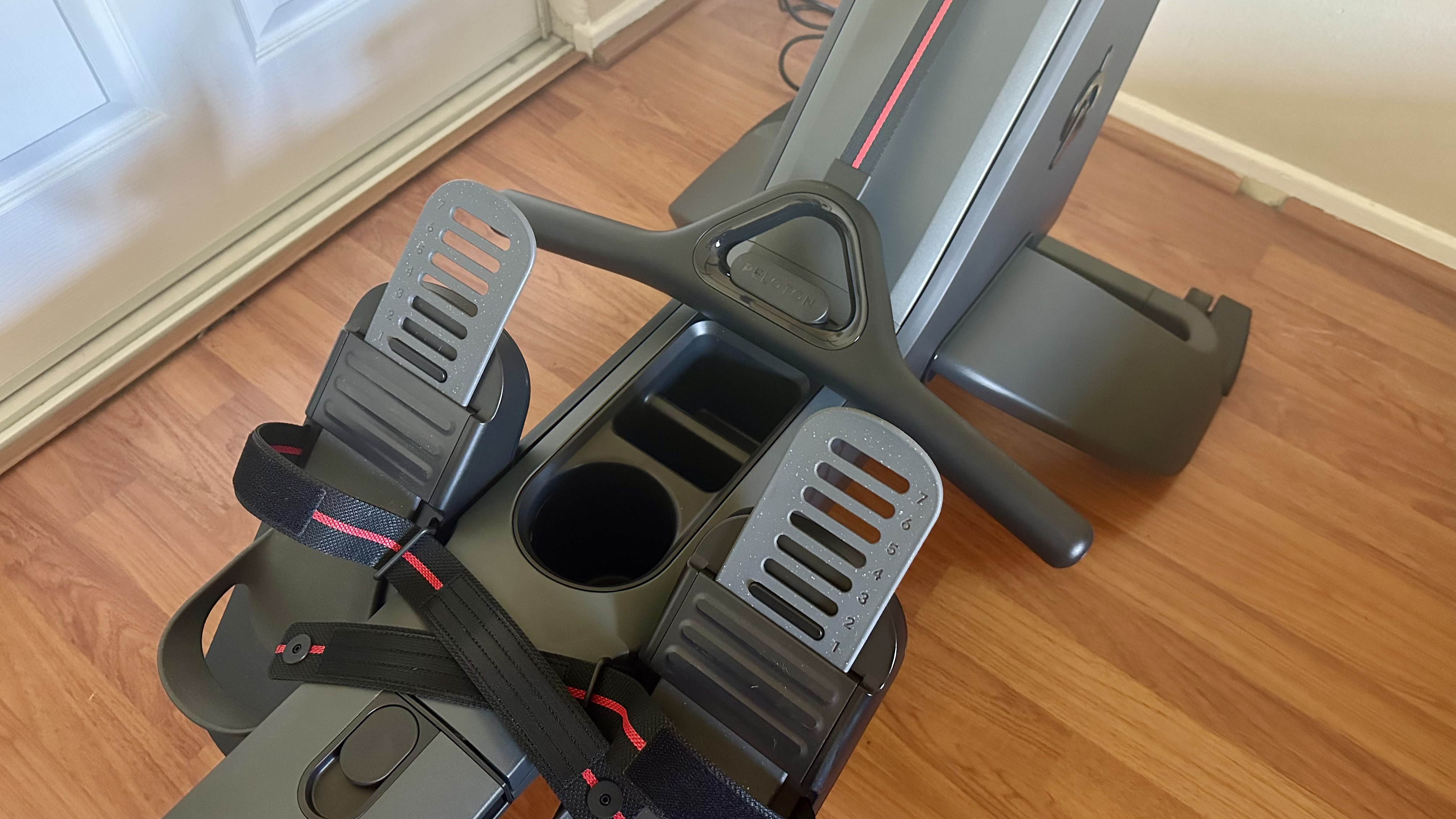
- $2,995 US plus a $44 per month All-Access Membership
- Not yet in UK or Australia
- Significantly more expensive than its rivals
The Peloton Row is only available direct from Peloton for $2,995. That’s after a recent price drop from $3,195. It’s currently only available in the United States, though there are plans to release the machine in the UK and Australia, similar to the Peloton Tread and Bike.
With the most basic Peloton Row package, you get everything you need, including setup, the 23.8-inch display, and a mount to store the machine upright. However, you’ll need to shell out another $44 per month for an All-Access Membership to access classes for the Row and all of Peloton’s other classes, from strength training and cycling to yoga and meditation.
Peloton offers a few other Row packages with additional accessories like mats, weights, and a water bottle. Given these bundles range in cost from almost $100 to just under $400 more, save yourself some money and pick these up elsewhere.
Don’t get me wrong the almost $3,000 price tag is hard to digest. But given the Peloton Row’s simple delivery and setup, impeccable design, exclusive features like Form Assist, and access to endless classes with motivational teachers, I can see the value. There are some much cheaper alternatives, like the Hydrow and Nordic Track RW900 Rowing, but they still don’t touch what Peloton has.
- Value score: 4/5
Peloton Row: Design
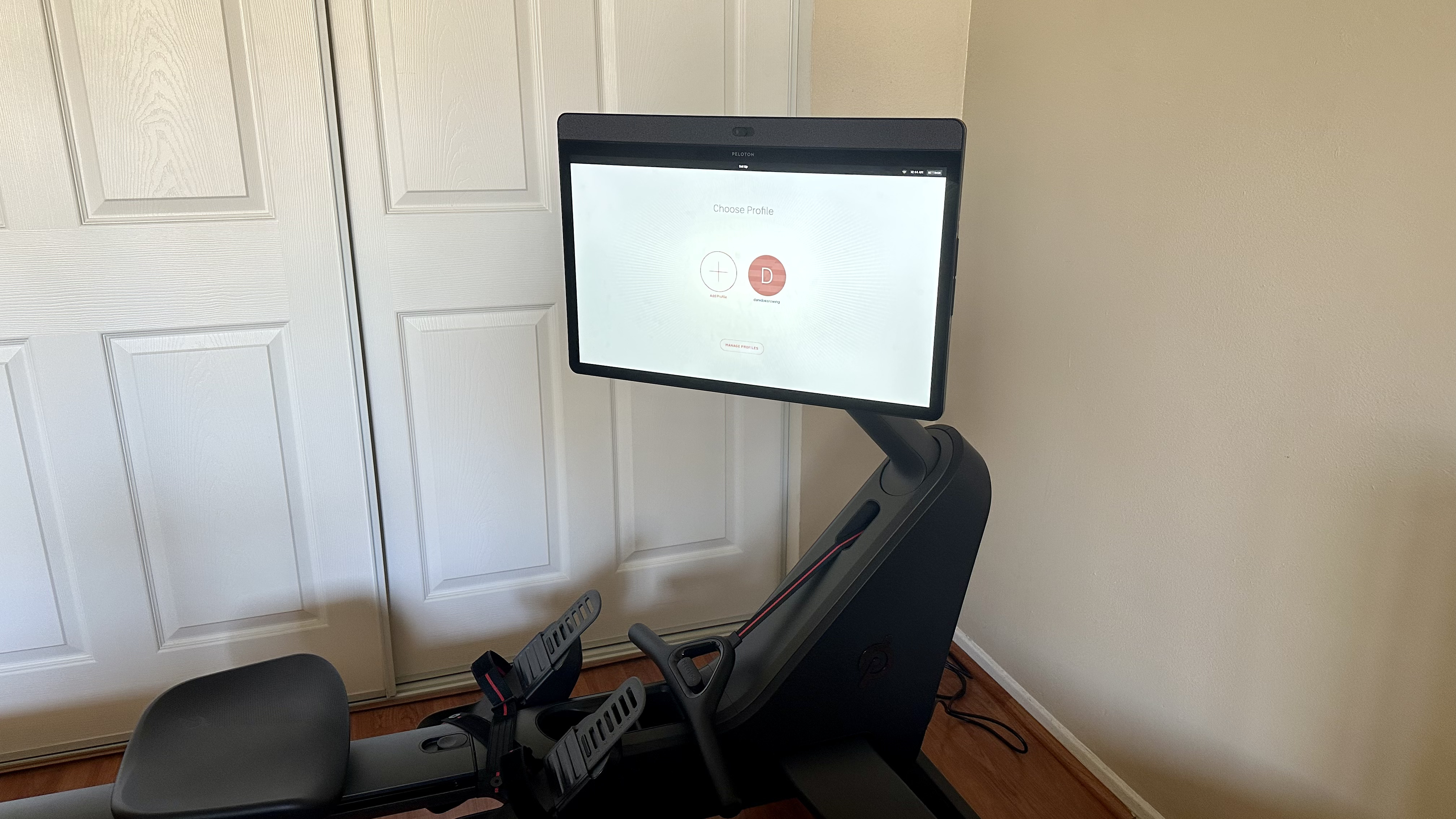
- Simple setup
- Functional design with wheels and handle for easier moving/storage
- Large, responsive full HD touchscreen
To say setting up the Peloton Row was simple would be an understatement, as you literally have to do nothing except let the delivery people into your home and show them where you’d like the machine. They do all the rest, including carting away all the boxes, ensuring you’re connected to the Peloton platform over WiFi, and answering any questions. All in all, it took about 15 minutes for them to set it up and another 10 to make sure you were ready to take your first class. Talk about convenience.
It’s a good thing the machine is set up for you because it’s big, about eight feet longtwo feet wide, and weighing almost 160 pounds. Peloton also recommends you leave two feet of clearance on all sides, which I’d also recommend to avoid running into things during your row. But if you plan on taking Row Bootcamp classes, you’ll need even more room. Therefore, those tight on space should stay away from this machine and rowing machines in general, as they all have bigger footprints. It just barely fits my spare room.
If you want to move the machine around, Peloton attempts to make the process as simple as possible by placing two wheels at the heavier end of the machine, and the back end is a loop shape, making it more functional for easier lifting. I’ve tried moving the Row around, and it’s heavy but manageable to do alone thanks to the wheels.
To save space in your room, there’s the option to store the Row upright (as long as your ceilings are over eight feet high). However, you need to install a wall anchor, which involves screwing the anchor into place. I couldn’t test this since I rent and can’t put holes in my wall. I still put the machine upright, and it wasn’t difficult; the display’s arm folds down, and you use the back loop and a handle on the rail to lift it. Peloton says you should be comfortable lifting 40 pounds to do this. If you choose to store upright, only do so using the anchor. instructors even mention this in many of the classes.
When it’s time to get rowing, there’s a large 23.8-inch full HD touchscreen that’s both bright and perfectly responsive. Colors are vivid and lifelike, while the 1080p resolution ensures decently crisp visuals. The display can fold down slightly and tilt to the sides up to 45°, which is handy for different viewing angles, especially when taking the Bootcamp classes.
At the top of the display, there’s a large speaker that’s clear and gets plenty loud, along with two rear subwoofers. You get an easy-to-reach volume button on the side, though you can also adjust the volume on the screen, and there’s a power button around the back. A seemingly useless camera with a privacy cover is included, which at the time of writing this review, only takes pictures for your profile.
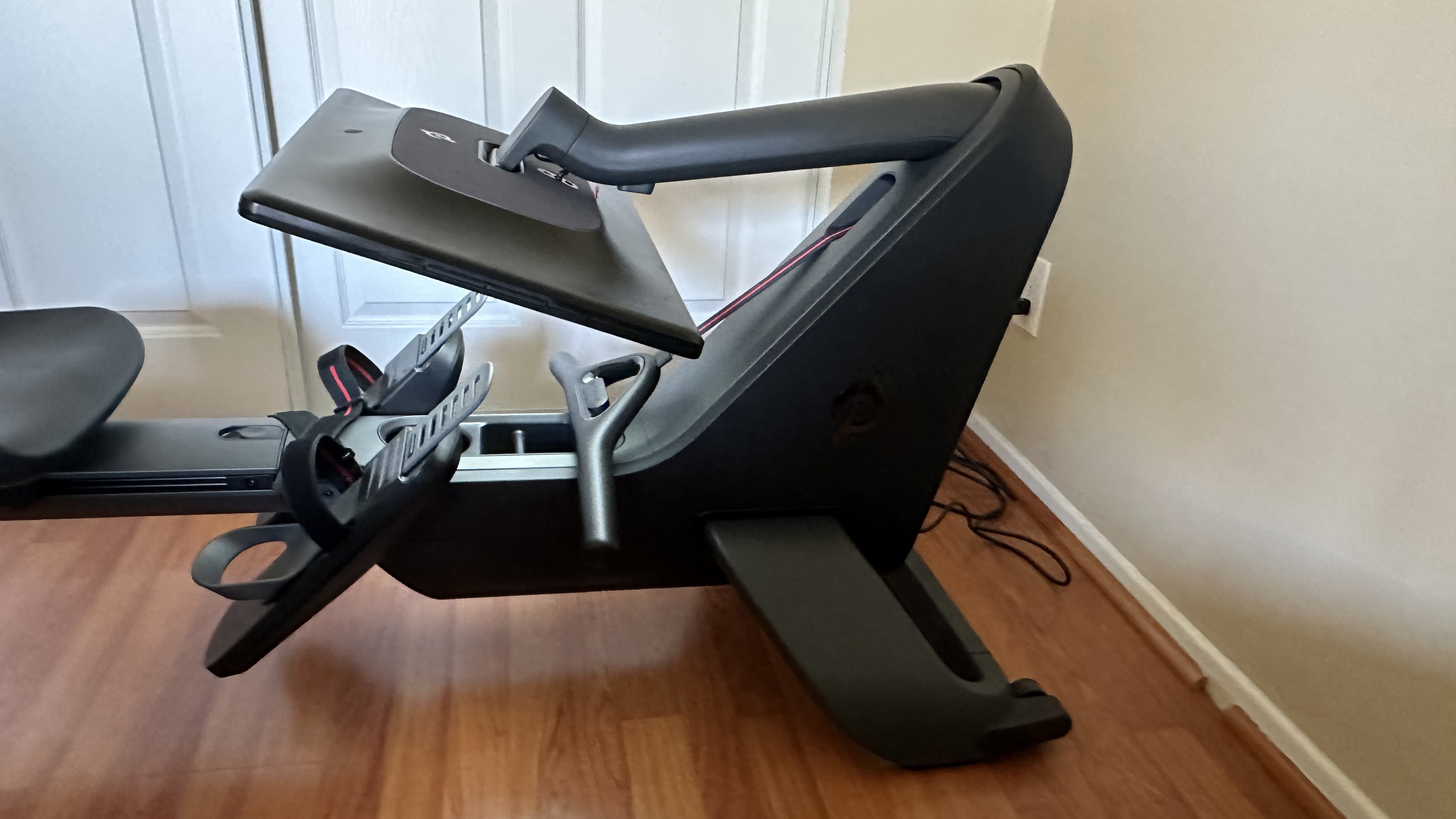
Moving on to the rail of the Peloton Row, it’s made of anodized and powder-coated aluminum that feels exceptionally sturdy. On top of that rail sits a lightly padded seat that slides along the length of the rail. At the base, there’s a footrest made of sturdy plastic with a movable shoe sizer. It’s simple to adjust the size options from one to seven and fits a women’s size five to a men's size 13.5. To secure your feet is a woven strap with velcro, and after a month of use, everything holds up great and performs the same as the day I got the machine.
Beyond the footrest, just under the display, is a molded plastic and TPE handle that’s easy to reach and grip with a simple docking knob. But be prepared to get a few calluses as you adjust to daily rowing. The Row uses electromagnetic resistance rather than water or air, making for a super quiet, but powerful rowing.
Unlike adjusting the resistance of an exercise bike, the Row uses a Drag Factor, which gets increasingly difficult as you pull the handle faster. You can change the Drag Factor between Light (100), Medium (115), and Heavy (130). Though it’s possible to go out of this range, Peloton recommends staying within those limits.
There’s not much else to the machine other than a little hub to put your water bottle, phone, and other smaller accessories. Overall, the Peloton Row is functional and well-designed, making it a joy to use.
- Design score: 5/5
Peloton Row: Performance
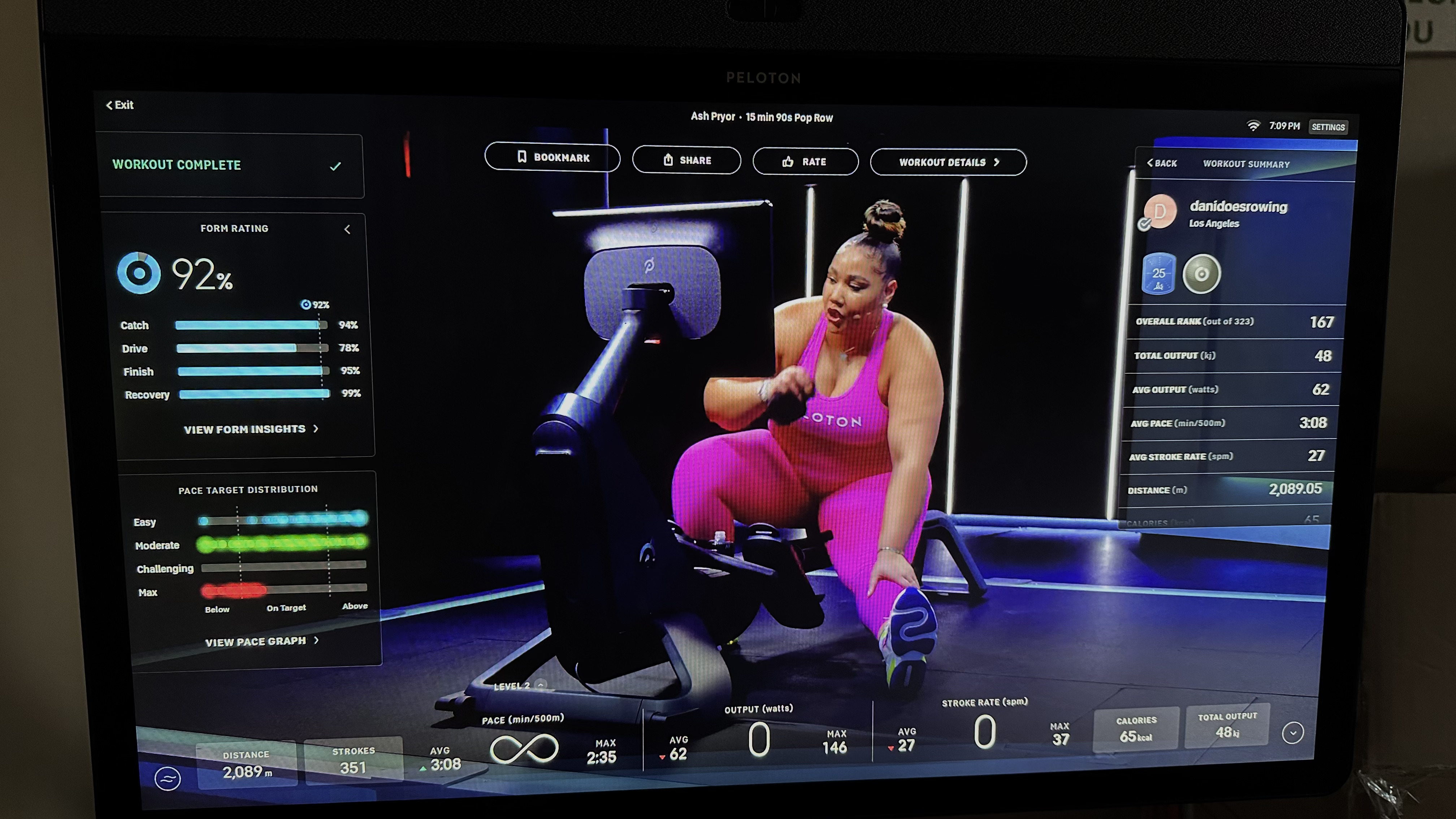
- Form Assist feature to perfect your stroke
- Motivating instructors and great community-building
- Worked flawlessly throughout testing
I’ve been rowing on the Peloton Row for over a month almost daily to see how it stacks up to regular use and experience all it has to offer. Beyond rowing, the Peloton All-Access Membership gives you access to a massive volume of live and recorded classes, including cycling, running, strength, and meditation. You can watch all those classes on the Row’s screen, but for this review, I focused only on the rowing classes: rowing and row bootcamp.
Before your first row, you calibrate the machine to you. The Peloton instructors guide you through the process. It only takes about five minutes, and you’ll learn about and take all the different positions for a proper row stroke. From there, the machine should be calibrated to your stroke, letting you use the almost life-changing Form Assist feature.
Form Assist is available in every class you take, appearing on your screen and following your stroke in real-time using sensors, not a camera. A gray human-figure icon moves with you, and when the feature detects improper form, it’ll highlight the area in red, telling you what the error is and how to correct it. It was distracting at first because the icon was constantly red, as I was relatively new to rowing and had no idea how to do a proper stroke. But at least it told me I was doing something wrong. Otherwise, I don’t think I would’ve known I had improper form, potentially injuring myself. It’s possible to minimize the Form Assist feature on the screen if you just want to focus on the instructor.
At the end of your classes, you’ll get a Form Assist score, which gives you an overall form rating percentage and a form breakdown percentage for each part of the stroke. I was lucky to break 50% during my first few classes, but now I’m closer to 90%. You’ll also get awards when your form is above 80%, a nice little incentive. Form Assist puts the Row a notch above all the other rowing machines on the market.
Beyond Form Assist, there are Form and Drills classes available to help you with your stroke. Anyone new to rowing should take these classes, as the instructors do an excellent job of breaking down each part of the stroke. I had no idea rowing involved more leg work than arms until I took these classes. I’ll still take Form and Drills classes from time to time to help improve my form. As your stroke improves, you’ll also want to recalibrate the machine, which is just as simple as the first time you do it. Peloton even offers programs to help your Row performance. At the time of writing, there are only two Row programs available, but clearly, if you’re new to rowing, this is the perfect machine to learn on.
Speaking classes, there are few to choose from, with the most common being a basic rowing class that often focuses on music themes like Classic Rock, 90s Hip Hop, etc. Each instructor chooses their playlist, and it’s always fun to hear the songs. You can even connect your Spotify or Apple Music account to save the songs, but I experienced some hiccups during connection.
Some other rowing class options include endurance, Tabata, interval, and HIIT. Each provides a slightly different experience. The classes last from 10-30 minutes, and I found them easy to fit into my daily schedule. Peloton also just added Extra 5 classes, which are handy five-minute classes to push yourself a little further after finishing a longer class. I love the short class structure; it makes me work harder since I know the pain will be over soon.
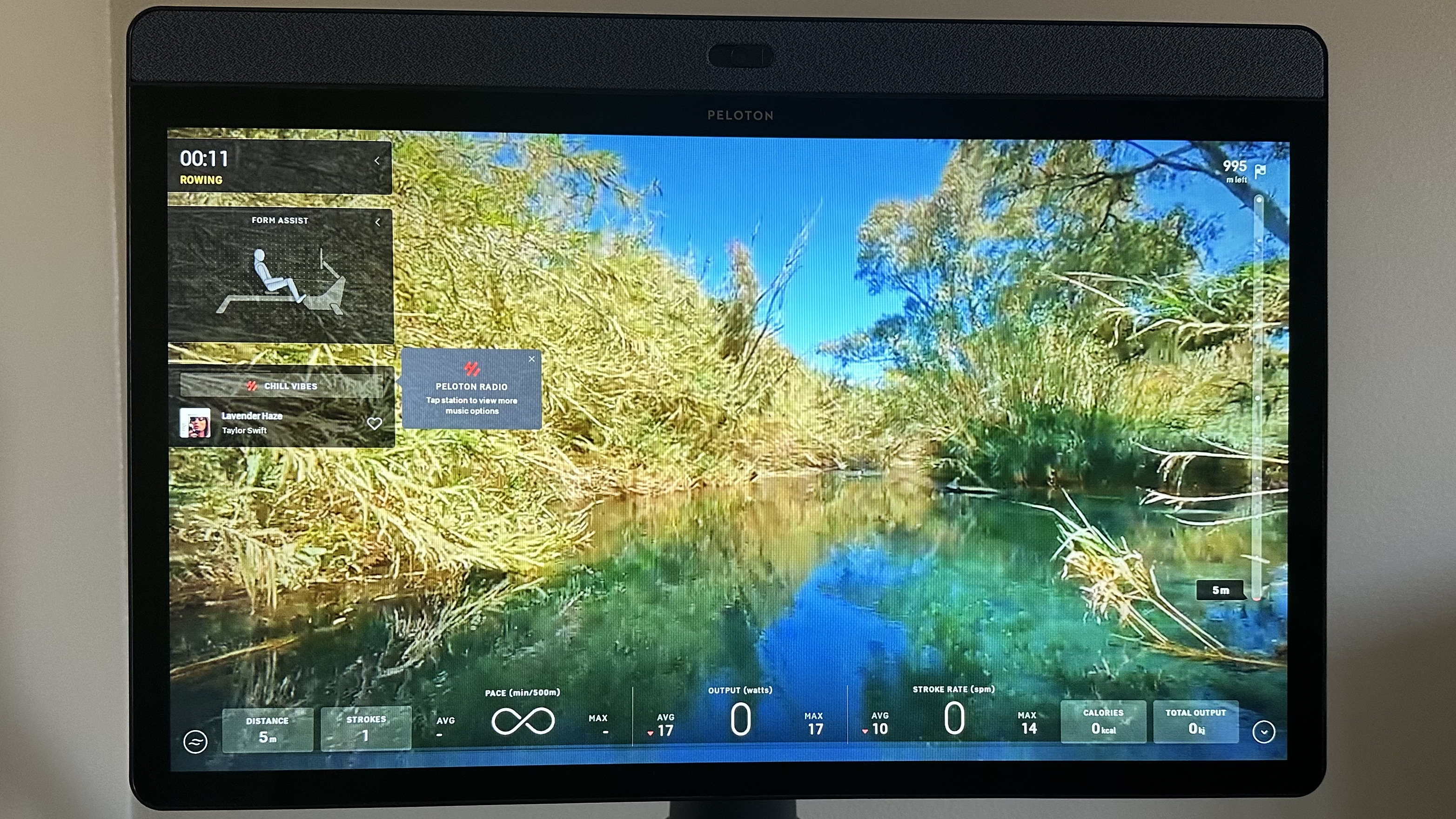
During all the classes, the instructors give you a pace and stroke rate target to hit for a certain amount of time. Before or during a class, you set your pace levels from 1-10. Within each level are easy, moderate, challenging, and max targets you’ll want to hit based on minutes to go 500 meters. So, at level two, a max pace should be between 2:40-2:20. Pace timings will be different for everyone, and it took me a good week to figure out how to increase my timing. It mostly involves your drive at the beginning of your stroke, not how fast you row. Stroke rate is how many times you complete a full stroke per minute.
Peloton is big on cultivating a community, so during class, there’s a leaderboard that ranks you based on output, another metric that’s basically the power behind each stroke. As you take a class, you can compete against other users, attempting to pass them on the leaderboard. It’s extremely motivating, and even more intense during live classes, as the instructors see your output and occasionally call you out, providing an in-person class vibe. Users also create hashtags for more specific groups within Peloton, and you can even virtually high-five people during class.
The instructors are all fun and motivating. Though similar to running on a treadmill or indoor cycling, I find rowing a bit repetitive and boring day after day, no matter who is teaching the class. Row Bootcamp classes add a little variety to your workout by combining rowing with mat strength training workouts to build up muscles to improve your stroke, using the machine’s rotating screen. These classes last a little longer, between 30 to 60 minutes. I’ve taken a few and enjoy them overall. However, I have limited space where my Row machine is set up, making them slightly more challenging to complete.
Pretty much all of the classes you take were “live” at one point, and you’ll even see the date and time of the class on it. Of course, you can take actual live classes, and Peloton provides an easy-to-use calendar to find them. My only issue is many of the live classes cater more to those on the East Coast of the US versus the West, as they’re filmed in the New York studio. That means there are a lot of excessively early classes or ones in the middle of the day that don’t work as well for those like me on the West Coast. It’s really a hit or miss, depending on the day of the week. Coming out late last year, the Peloton Row is still relatively new, so I assume as more people get the Row, demand will increase, and we’ll see more live classes.
Beyond typical classes, there are self-led scenic rows that let you row in different locations from Greece to South Carolina, putting you in the driver's seat of the boat traversing different waterways. It’ll pick up pace as you do. However, there are still only a limited amount of scenic rows. There are even a few scenic row classes with instructors rowing an actual boat on the water that you follow along with, but these are also limited.
Peloton is beta-testing an option to watch Netflix as you row, which is ideal for those who get bored of the repetitive exercise. One final rowing option is “Just Rowing.” It’s exactly what it sounds like, and the only thing you’ll have access to if you don’t pay for the $44 per month All-Access Membership. So, if you buy the machine, be prepared to shell out extra dough because even though the Row is great, the classes make it.
For those that have the Row in a communal space, there’s Bluetooth connectivity to connect wireless headphones. It’s super simple to set up and works flawlessly. I had no problem connecting my AirPods, so the only sound others hear is the machine going through the motions and your heavy breathing, and the machine is whisper quiet, hitting only dB. I also connected my Bose SoundLink Mini II speaker with no issue blasting the volume during class, giving you even more of an in-person experience. The built-in speakers can get loud, but the sound gets distorted at super high volumes.
To get even more health data when using the rowing machine, it’s possible to connect a heart rate monitor or smartwatch to see and save your heart rate data as you work out. I attempted to use this feature, but unfortunately, my older FitBit Sense is not compatible.
As for the actual machine’s performance, I have no complaints. All the components work just as great as the day it came. The seat still glides with ease, and the footrest feels secure with every stroke. I have gotten a few small callouses on my hands from gripping the handle, but instructors warned me about this, so it wasn’t a surprise. The Full HD touchscreen attracts tons of fingerprints, but it’s perfectly responsive, working just like a giant tablet.
Maintaining the Peloton Row is as simple as can be. It mainly involves ensuring the area underneath is clear and occasionally checking for damage, especially near the power cord, handle strap, and foot straps. Beyond that, you’ll want to wipe down the machine monthly with a damp cloth and mild household cleaner, or possibly more if multiple people are using it. I can attest that things get sweaty, so keeping up with this is essential. And as they say at the end of pretty much every class, “If you’re storing the Peloton Row upright, be sure you’re using the wall anchor.”
- Performance score: 4.5/5
Peloton Row: Scorecard
Peloton Row: Should I buy?
Buy it if...
Don't buy it if...
How we tested
For over a month, I have used the Peloton Row almost daily. My usual workout routine consists of pilates five days a week and walking or hiking every day. It wasn’t difficult to incorporate rowing into this routine, as many of the workouts are short, making for an easy way to add an extra dose of cardio.
I tried out every type of row class available including HIIT, endurance, and tabata. There are also Row Bootcamp classes that are a bit more involved, and I took several of those. Finally, I took a few live classes to see what the experience was like.
First reviewed: November 2023







